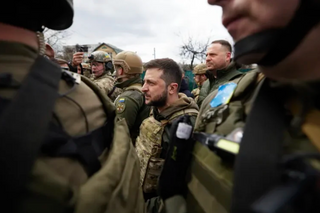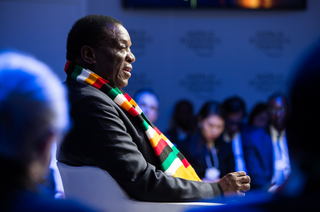News
In the Russia-Ukraine War, a Fighting Spirit, Logistics and Leadership will Play as Big a Role as Technology and Numbers
The war has been depicted as a blend of the tactics of the Somme and of future war, the difference between mud, trenches, shredded trees and guts versus drones and AI-driven networked warfare.

The blue walls outside St Michael’s Monastery, the seat of the Ukrainian Orthodox Church, are covered with the photographs of Ukrainian soldiers who have died in the defence of their country since 2014. More than 20,000 faces stare out, posing proudly; their promise denied. Families gather to pay their respects, leaving behind tears and taking away memories.
The square alongside has become a display for mangled and burnt hulks of Russian tanks, self-propelled guns, Buk surface-to-air missile launchers and various types of armoured personnel carrier. Citizens of Kyiv walk their dogs or flash past on their electric scooters without a second glance.
Yet, apart from the reminder of regular air raids and wailing sirens and despite the presence, still, of Russian forces just 200km away on the other side of the border in Belorussia, the war now seems a long way from Kyiv. There is no longer an imminent risk of an attack to capture the capital or decapitate its government, as there was in the first month of the war and as the Russians attempted with their airborne strike to establish an air bridge at Hostomel Airport (Antonov Airport) in the war’s opening act on 24 February.
In an action that became known as the Battle of Antonov Airport, led by Spetsnaz special forces and VDV airborne troops, the damage inflicted on these units and the planes and helicopters carrying them and to the runway, by a mixed contingent of Ukrainian regular and part-time forces was enough to stall and then blunt the Russian attack. It gave time for the Ukrainians to blow the bridges in Irpin and Bucha, slowing any advance into Kyiv.
And so the stage was set for the conflict, which continues 18 months later.
In the process it features the old and new in warfare, low-tech and hi-tech, ancient principles and modern techniques, a mix of conventional war and (counter) insurgency, and that conducted at hypersonic speeds and a version of (virtually) static trench warfare.
This is encapsulated in the depiction of the war as a blend of the tactics of the Somme and of future war, the difference between mud, trenches, shredded trees and guts versus drones and AI-driven networked warfare.
Certainly, some things are familiar.
The Ukrainian counteroffensive is today slowly grinding its way forward through Russian lines in the southeast and east, a system involving six lines of fortifications 20km deep, including physical defences, from ditches and berms to dragon’s teeth and barbed wire, elaborate trench networks, and extensive and multilayered minefields. This is similar to the German system developed by the end of World War 1, where the frontline of trenches, known as the outpost line, was held by scattered machine gunners distributed behind dense entanglements of barbed wire, the main line of resistance being a parallel series of two, three or four lines of trenches containing the bulk of the defending troops. The defenders’ artillery was posted to the rear of the main line of trenches. The Germans evolved an intricate defence system employing concrete pillboxes to house machine guns, with trenches behind, some out of the range of Allied artillery. By 1918 the Germans had constructed some systems with a depth of 14 miles (22km). Russia’s use of phosphorous mortar rounds against civilian targets – such as I personally witnessed in Kherson – similar to the use of mines and indiscriminate shelling as a weapon of terror, also harks back to an era of limitless warfare, at least in terms of conventional weaponry.
It is precisely to circumvent such a defensive system that militaries originated combined-arms warfare, the careful integration of different combat arms, involving infantry and artillery, and ground and air forces. This approach has its origins in German efforts to break the Allied lines in 1917. Rather than rely on a sequential approach, with mass artillery fire followed by often suicidal infantry attacks on foot, combined-arms meshed artillery as covering fire for advancing infantry with engineering to clear mines and barbed wire.
A more accurate analogy to the Russia-Ukraine war is probably actions around Normandy in 1944 given both the relative force densities (10,000 per mile on the Western Front, 1,000 in Normandy and 700 Russian troops today along a 800-mile front) and the ability of the attacker this time around being able to break the technological deadlock of World War 1 with a combination of the right weapons and sufficient force levels as well as an acceptance of high casualty numbers. Moreover, for the most part, the Russia-Ukraine war has been marked by remarkable fluidity, with rapid Ukrainian territorial gains in the 2022 battles of Kyiv, Kharkiv and Kherson.
Mass and manoeuvre remain important. Although the current offensive is portrayed as “a war of attrition”, this is not a static situation. Attrition can shape the extent of freedom of manoeuvre and vice versa since the degradation of an opponent’s forces in attritional warfare can lead to the bold breakthrough sought. Attrition, as Sir Lawrence Freedman notes, tends to get “disparaged as an inferior and undesirable form of warfare, requiring patience and an ability to absorb pain, without necessarily offering a plausible route to victory”, not least since Europeans in particular have an aversion to the concept given events of 100 years ago. Yet it may well be the precondition for success.
Some of the difficulties experienced by the Ukrainians are that they don’t have the mass necessary for success, or are unwilling to commit their reserves and absorb the casualties that will grant them this aspect. This is understandable in a nation that respects the sacrifices being made, and the difference between a Russian war of choice and the Ukrainian one of national survival.
The fighting grit and morale of soldiers is crucial, which seems to have given the Ukrainians an edge, despite the older average age of combatants.
This war has reinforced the centrality of intelligence, tactical as much as strategic. The West were able to signal clearly Russia’s intentions before the invasion, and clearly their imagery has proven important in the tactical battle. But there have been faults in this approach, not least that political fecklessness in the West undermined the signalling of Russian intent.
While Russia has attempted to portray the war as a liberation rather than an occupation, there have been dramatic costs for civilians, in terms of lives as well as infrastructure.
Conditions continue to matter. Terrain, weather, cover and concealment and soil conditions have proven as important as they did 80 years ago, especially in tank warfare. Similarly, the fighting grit and morale of soldiers is crucial, which seems to have given the Ukrainians an edge, despite the older average age of combatants, which tends to make them more cautious. This reflects a decision early on in the war not to call up Ukrainians aged 18 to 27 so as to preserve future generations. No doubt other Nato countries will note the need for a well-trained reserve.
So does logistics. General Omar Bradley might have declared that “amateurs talk strategy, professionals talk logistics”, but this tenet of warfare has not been internalised by the Russian military, which continues to have big problems with provision, worsened by corruption. The scenes of the long convoys stuck making tempting targets at the start of the war is testament to these troubles. By contrast, the speed of supplying the Ukrainians has been a key factor in its relative battlefield success.
Asymmetry also remains a feature of the modern battlefield, though with a different twist to the manner in which this occurred in Iraq and Afghanistan.
An effect of American technical and material advantage since 1945 has been to drive opponents to nullify technology by fighting asymmetrically, such as via insurgency and terrorism. Iran has similarly attempted to deter and challenge the US by building a network of proxies and equipping them with cheap weapons including surface-to-surface missiles, SAMs, drones, IEDs and fast small boats.
Asymmetrical war
From a Ukrainian perspective, the war is asymmetrical, not least if one looks at relative population numbers (140 million for Russia; 40 million, less seven million refugees in Ukraine) or economic strength ($2.4-trillion versus $160-billion; or $10,078 versus $2,032 per capita). Thus, says Hryhoriy Nemyria, the deputy chair of the foreign affairs committee in Ukraine’s parliament, “there is a need to activate other asymmetries, including diplomatic and technological”.
Ukraine shows, too, that an asymmetry of national interest can also translate into an asymmetry of advantage. This can cut both ways. While Ukraine has more at stake than Russia (though perhaps not President Putin right now), Russia has more at stake than the US, just as Pakistan and Iran had over Afghanistan, or Iran in Iraq. In the long run, this can, as the British strategist Mike Hart points out, result in asymmetry of advantage, despite the apparent disparity in military and economic power.
It’s a war being fought with old blood and guts on the battlefield, but also by geeks behind their laptops.
This tendency is reinforced by the realities of Western political cycles, particularly when wars become unpopular or contentious. It is not unreasonable to argue that relative advantage over time shifts against the West in discretionary interventions. And yet short wars are generally the exception, especially given the long periods required for stabilisation and state recovery even when the initial military action has ended.
The asymmetry of weakness against strength is present in Ukraine, but with a twist. It is less in the case of this war about turning your weakness into an advantage, as with insurgents against the US in Afghanistan for instance, than a search for asymmetrical advantage.

This turns on a combination of technologies themselves, the speed of operation and the ability to integrate and apply technologies. This requires operator skills and endless innovation and application, hence the literally hundreds of basement drone manufacturing and R&D facilities across Ukraine. It’s a war being fought with old blood and guts on the battlefield, but also by geeks behind their laptops. The speed and ability to integrate these two worlds – old and new, pulling a trigger and flying a drone – is the difference between success and failure. AI is shaping the battlefield, for example, by synthesising multiple inputs in calculating exact targeting data.
There is more to fighting than military capacity or speed of operations, however. You can’t win a war without a viable strategy, which is to say relevant war aims, consistently maintained over time, are a realistic course of action and operational timeline and sufficient resources. Strategic choices need to be feasible, resulting in courses of action that could conceivably lead to the accomplishment of one’s goals. You also can’t win a war without motivation, at the individual level, in getting soldiers to fight and families to support those fighting, and by building a sense of national purpose. And then there is the international dimension.
Strategy is thus as important today as before, as is the alignment of external and internal interests between Ukraine and its international partners. There remains, however, a danger of being fixated on troop numbers or the deployment of technology. These are enablers. What is important is how these will be employed. For that there needs to be shared goals, preferably based on shared values and not just shared national interests.
In the same way, there is a danger, too, in becoming stuck on singular metrics of progress, such as square kilometres of territory gained or the equipment being sent. This is no more useful than Vietnam War-era body counts. It says little about the will of the Russians to fight and the extent of their materiel degradation. It also says nothing about the differences behind this resolve, not least between a system centred on one man (Putin) and another committed to improving democratic governance. One may operate within clearer political constraints, and the other occasionally slower, but less vulnerable to personal traits, influences and foibles. It also has the advantage of moral authority – except among the amoral.
Possible outcomes
Now that the danger of overwhelming Russian conquest has dissipated, there are currently three imaginable scenarios for the outcome of the war in Ukraine:
The first of these is “Victory for Ukraine”, in which they force the Russians out of their occupied territories and, through international guarantees (such as Nato membership) and military strength or a different regime in Moscow, ensure that they never try to return. In a perfect outcome, the return of children and POWs and reparations are agreed as part of the process.
A second is “Settlement” around a possible armistice or negotiation, which leads to a version of the above or, in a less perfect outcome, simply setting the scene for another Russian attempt once it has regrouped and rearmed itself. This scenario would likely have to settle the occupied territories in Ukraine’s favour, without which there could be political upheaval.
A third outcome is for “Stalemate”, where a lack of international support, whether through a lack of capability fatigue or even a political about turn, leads to the Ukrainian offensive stalling against stubborn Russian defences. Such international fickleness could be founded on a simplistic understanding of the conflict; put differently, that it will be settled by peace.
Just outside Kherson, on a side road north to Mykolaiv, a band of 40 territorial Ukrainian soldiers, part-timers, mounted a stand against two Russian armoured columns. As the Ukrainians were armed only with rifles and Molotov cocktails, says Sergei, our guide and member of the resistance, the result was inevitable. Nineteen of the 40 were killed, the trees bearing signs of a withering crossfire from the Russian columns. Nineteen saplings have been planted in remembrance of this heroic if hopeless defence. It was hopeful, however, considering the galvanising effect it had on fighting spirit, unbroken in Kherson despite nine months of subsequent Russian occupation.
“When we look back on this war,” says Andriy Zagorodnyuk, Ukraine’s former defence minister, “what started seemingly with Molotov cocktails will end with drone on drone warfare.”
What will get them to that conclusion, however, is not just technology, but also the more prosaic qualities of grit and determination, leadership and logistics, and ability to win the argument.
This article originally appeared on the Daily Maverick
Photo: Rawpixel


